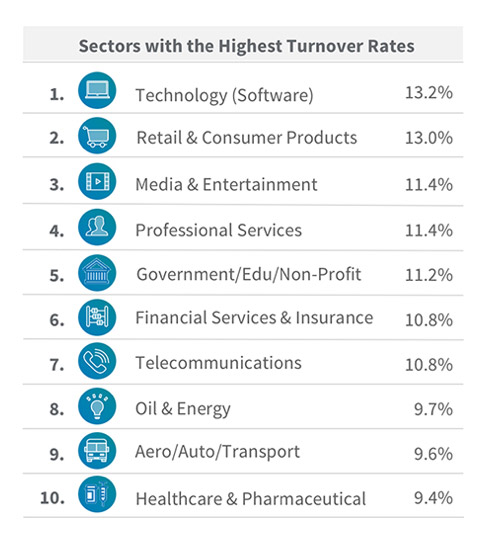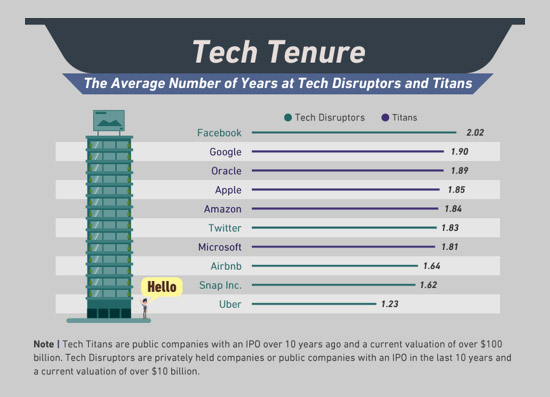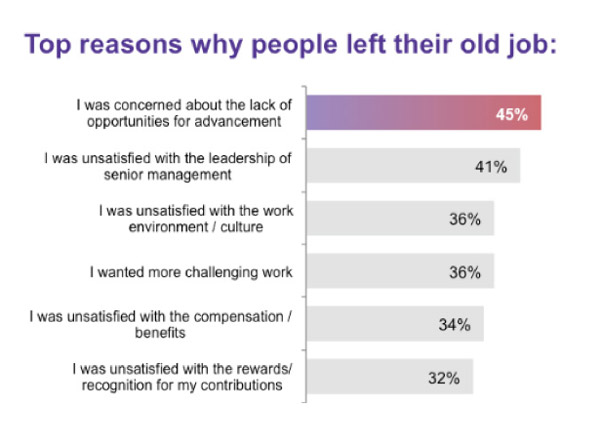
Employee attrition is one of the most important challenges facing companies in 2018. It’s disruptive, expensive, and detrimental to productivity.
According to a recent report by the Hay Group, the turnover rate for 2013 to 2018 will average 23 percent, with 192 million people leaving their current employers this year. According to talent acquisition marketing expert Maren Hogen:
- A third of new hires quit their job after about six months
- A third knew whether they would stay with their company long-term after their first week
- And a third of leaders at companies with more than 100 employees are currently looking for jobs
And the technology industry is suffering the most.
LinkedIn’s analysis of half a billion professionals found that the highest attrition rates come from technology (software), followed by retail, media, and professional services.

A Paysa study of the top ten tech companies shows just how dire the situation is. For example, Facebook boasts the highest retention rate, with employees serving an average tenure of just 2.02 years. At Amazon the average period is just a year, and at Google it’s 1.1 years.

A high attrition rate can have a huge impact on an organization’s bottom line. Considering the fact that attrition can cost anything from half of an entry-level employee’s salary to over 125 percent of salary for senior or technical specialists, it’s no wonder that 78 percent of business leaders rank retaining employees as important or urgent.
But before we can make any progress in solving the problem of high attrition rates, we need to make sure we really understand why employees leave in the first place.
The reasons an employee leaves
LinkedIn’s survey of 10,000 job switchers found that the top reason that employees left jobs is a lack of career opportunity. This is followed by poor leadership and an unhappy environment or culture, respectively. Other examples include being unchallenged in work or unsatisfied with their compensation or recognition.

In the technology sector in particular, employee attrition is being driven by increasing demand and the correlating increase in compensation. Data analysts, UX designers, and software engineers are in extremely high demand, with embedded software engineers receiving the most InMails per person in North America. It’s easy for employees to leave when they have so many opportunities and offers.
A quick look at attrition in the other two industries shows that both retail and media organizations traditionally expect high turnover, due to the seasonal, low-level nature of retail jobs as bricks-and-mortar stores transition to e-commerce, and the project-based nature of many media industry jobs.
The good news for HR leaders in the tech industry is that a high attrition rate is completely avoidable, once you’ve identified the problem.
How to calculate attrition rates
To start with, you should always monitor your company’s attrition rate. We’ve covered how simple it is to calculate attrition before, but to summarize, the formula for your company’s employee attrition rate is the number of employees who have left per month divided by the average number of employees, multiplied by 100. You can also calculate your year-to-date rate by adding all the results from a period of time together, or add all 12 months together to calculate annual attrition.
But it’s not over once you calculate the attrition rate. Whether you have high or low attrition, it’s not enough to have a bandaid solution to reduce it or do better next month. You need to develop long-term strategies in order to effectively maintain a low attrition rate.
Related articles: More on how to use this easy formula and the causes of attrition
Preventing turnover takes investment
Retaining employees long-term requires a robust strategy to ensure that employees have lots of opportunity for training, advancement, and internal mobility, feel listened to by senior management, and fit into the organization’s culture. Simply offering unengaged employees more money won’t cut it.
In the tech industry, we’ve covered some specific steps for fighting attrition, which include recruiting with retention in mind and encouraging innovation and autonomy.
Companies that enjoy the lowest attrition rates in the sector have invested in retention, which can start with new hire integration. This includes regular mentorship, introductions to senior management, invitations to diversity initiatives, 360-degree performance reviews, real-time feedback, and the creation of a career advancement road map.
Software can make it easy to retain employees
Our integration software is designed to help busy HR leaders implement best practice strategies across offices, geographies, and practice areas. It plugs into your existing platform to help you structure tailored integration and retention pathways for all new employees.
The platform offers a best practice program out of the box, which you can tailor as needed, or you can input your own roadmaps to reduce your staff churn rate.
Want to learn more?
We’d love to take you through a short demonstration of our Employee Integration software. To select a time frame for your demo, just follow the link below and leave your organization details.